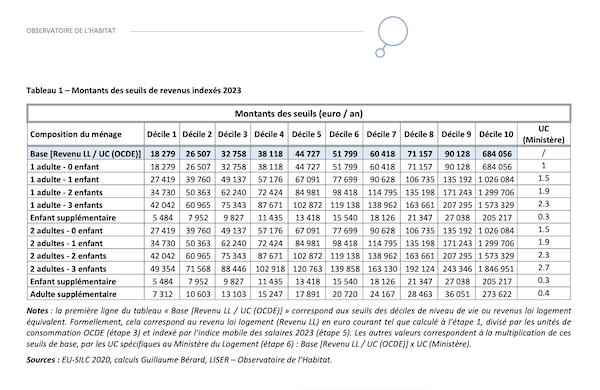 Indexed income threshold amounts for 2023;
Credit: Ministry of Housing and Spatial Planning
Indexed income threshold amounts for 2023;
Credit: Ministry of Housing and Spatial Planning
On Friday 14 February 2025, Luxembourg’s Housing Observatory released an analysis report (No. 16) detailing the calculation of income thresholds for the Housing Law in the Grand Duchy.
The latest report aims to outline the methodology used to calculate the income thresholds that are revised under the housing law, specifically in relation to the implementation of two key legislations on individual assistance and affordable housing. The note provides a detailed explanation of the calculation method for these thresholds (expressed in income deciles in accordance with the legislation), as well as various parameters defined under the housing law, such as income and household composition, which are used to determine the applicable income caps. These thresholds are considered crucial in determining eligibility and the level of rental guarantees, rent subsidies, interest subsidies, property access grants, as well as eligibility for affordable housing and the affordable rent amount, based on the income and composition of the concerned household.
In its recent work, the Housing Observatory used the European Union Statistics on Income and Living Conditions (EU-SILC) survey database, produced by Eurostat, to carry out these estimations. This survey aims to collect annually cross-sectional and longitudinal data that are harmonised across European countries since 2004, covering income, poverty, housing, social exclusion, and living conditions of households.
The most relevant data for this study pertains to income (salaries, social benefits, taxes, etc.) and the characteristics of the household and its members (e.g. occupation status, household type and size, age, profession or occupation, etc.).
Note that the definition of a household in the EU-SILC survey is equivalent to the definition of a household (or domestic community) according to the housing law. Also noted in the report is that in the EU-SILC survey, the income variables correspond to the year preceding the survey's reference year (e.g. the income declared in the 2020 EU-SILC survey refers to the income received by households in 2019).
To estimate these thresholds, the following steps are undertaken in Analysis Report 16:
- estimation of the net income for each household's domestic community, using the income data declared in the EU-SILC survey;
- determination of the number of children dependent on the household, based on the variables from the EU-SILC survey regarding the characteristics of individuals within the household;
- application of the OECD modified equivalence scale to the estimated income, in order to obtain the equivalent income (standard of living) serving as the calculation basis;
- calculation of the income thresholds for the deciles of living standards;
- application of the salary indexation scale to adjust the living standard threshold amounts for the desired year;
- application of the equivalence scale for household composition as defined by the Ministry of Housing to the living standard thresholds, to achieve a distribution of threshold amounts by household type.
IK
Updated to correct analysis report number (16 not 15)








